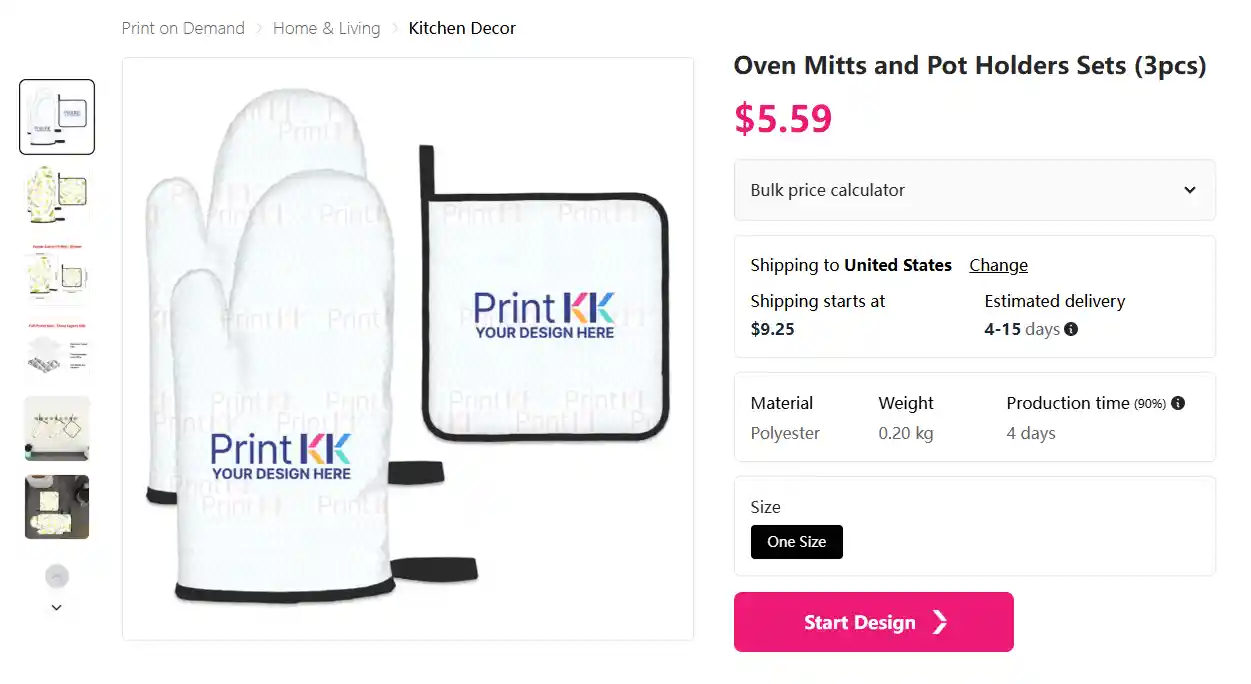
For those looking to enter the POD market, identifying a low-competition niche can be a game changer. By targeting a specific segment, whether it's niche hobbies, regional trends, or unique artistic styles, you can cater to a dedicated audience seeking something special that mainstream markets don't provide. This not only helps in establishing a loyal customer base but also allows for more creative freedom in product design, setting your brand apart in a crowded digital marketplace.
However, if you can't wait to learn about high quality custom products to complement your product list, join PrintKK now and enjoy the personalized experience! Get our exclusive $5 coupon and save on your first order!

What Is a Print-on-Demand Niche?
In the dynamic world of e-commerce, a print-on-demand (POD) niche is a specialized market segment that focuses on creating and selling custom-printed products. Unlike broad market strategies, a POD niche zeroes in on specific interests, communities, or themes, offering unique and often personalized items. This approach is particularly effective in the POD model, where products are printed and shipped only after a sale is made, reducing inventory risk and allowing for greater flexibility in product offerings.
For those looking to enter the POD market, identifying a low-competition niche can be a game changer. By targeting a specific segment, whether it's niche hobbies, regional trends, or unique artistic styles, you can cater to a dedicated audience seeking something special that mainstream markets don't provide. This not only helps in establishing a loyal customer base but also allows for more creative freedom in product design, setting your brand apart in a crowded digital marketplace.
The Importance of Niche Research in Print on Demand
Embarking on the path of POD business, it's crucial to understand the importance of identifying a low-competition niche. This isn't just about spotting a market gap; it's about aligning your passion with the interests of your customers. For entrepreneurs and designers, niche research stands as the foundation of a thriving POD business, illuminating the path to understanding what unique, under-served products your potential customers are searching for.
The value of this research is immense. In a digital sea of generic products, a well-researched niche can set your brand apart. It's about crafting products that connect deeply with a specific audience, whether through custom designs, poignant messages, or uncommon themes. This targeted strategy not only minimizes competition but also fosters customer loyalty. You're not just selling items; you're meeting the distinct needs and passions of your audience. In POD, uniqueness isn't just beneficial—it's essential.
How to Find Niches for Print on Demand?

1.Reviewing Your Passions and Interests
Finding the right niche in the POD world begins with introspection, focusing on your passions and interests. This step is vital for entrepreneurs, designers, and brands aiming to make their mark in the POD marketplace. Ask yourself, what subjects captivate you, or what hobbies do you find endlessly fascinating? These personal affinities are not just a source of inspiration; they can guide you to a niche that's both personally rewarding and less crowded.
Leveraging your interests isn't merely about tapping into a market; it's about connecting authentically with a community that shares your passions. This approach helps in crafting products that don't just sell but resonate with your audience, embodying a story or feeling that's deeply rooted in what you value as a creator.
2.Doing the Print on Demand Keyword Research
Once you've aligned your passions with potential niches for your POD venture, the next crucial step is keyword research. This process involves exploring and analyzing search terms that people use when looking for products like yours. It's a blend of art and science, where you delve into data to discover what your target audience is searching for, but not finding enough of in the market.
Tools like Google's Keyword Planner or various SEO platforms can be invaluable here. They help you identify terms with high search volumes but low competition, revealing untapped niches ripe for exploration. This methodical approach not only guides your product development but also shapes your marketing strategies, ensuring that your POD products don't just meet a need but also get seen by those who need them most.
3.Utilizing Ai Niche Generator Tools
In the quest to find low-competition niches for POD, leveraging AI niche generator tools can be a game-changer. These innovative tools use artificial intelligence to analyze market trends, consumer behavior, and search patterns, providing insights into untapped niches that might not be obvious at first glance. For entrepreneurs and designers, this means gaining access to data-driven suggestions that are both current and relevant. These tools can help you discover unique niches that align with emerging trends or specific interests, offering a significant advantage in a competitive market.
By incorporating AI-generated insights into your niche selection process, you can uncover opportunities that are not only unique and less crowded but also have the potential for growth, ensuring that your POD products stand out and resonate with a targeted, engaged audience.
4.Identifying Sub-Niches with Lower Competition
Identifying sub-niches within the broader POD market is a strategic approach to finding areas with lower competition. Think of it as narrowing your focus to cater to a more specific segment of consumers. These sub-niches can be based on unique interests, specific hobbies, or even niche demographics. For instance, instead of just targeting 'animal lovers', you could focus on 'tropical bird enthusiasts'. This targeted approach allows entrepreneurs and designers to create more personalized and relevant products for a dedicated audience.
By honing in on these sub-niches, you not only face less competition but also build a stronger connection with your customer base. This methodology is particularly effective for brands and artists who want to distinguish their offerings in a crowded market, creating a loyal customer base that appreciates the specialized attention to their specific interests.
5.Utilizing Long Tail Keywords
Utilizing long-tail keywords is a clever strategy for pinpointing low-competition niches in the POD realm. These are longer, more specific phrases that shoppers are likely to use when they're closer to a point of purchase or when they're searching for a very specific item. For instance, instead of a broad term like 'funny t-shirts', a long-tail keyword might be 'funny science teacher t-shirts'. These keywords not only help in targeting a more defined audience but also face less competition, making it easier for your products to rank higher in search engine results.
For entrepreneurs and designers, this means attracting an audience that's actively searching for exactly what you offer. Leveraging long-tail keywords effectively in your SEO strategy and product descriptions can lead to higher conversion rates, as your offerings closely match the specific needs and desires of your customers.
6.Guaranteeing Copyright-Free Designs
In the POD landscape, ensuring your designs are copyright-free is not just a legal necessity, but also a strategic approach to finding low-competition niches. This involves creating original designs or using royalty-free elements that don't infringe on existing copyrights. For entrepreneurs and artists, this means delving into creativity to produce unique and authentic works.
The benefit of this approach is twofold: it protects you from legal complications and propels your brand into spaces where competition is sparse. Many niches remain unexplored due to the complexities of copyright issues, so navigating this area carefully can open up new, lucrative opportunities. By prioritizing originality and copyright compliance, your POD business can stand out with its distinct and legally sound offerings, resonating with a customer base that values originality and ethical practices.
7.Optimizing Titles, Tags, And Descriptions of Your Products
Optimizing the titles, tags, and descriptions of your print-on-demand products is a crucial step in carving out your niche and ensuring your items get noticed. This is where SEO (Search Engine Optimization) plays a pivotal role. A well-crafted title with relevant keywords can dramatically increase the visibility of your products. Tags further refine this by categorizing your products under specific, searchable terms.
The description is your chance to not only provide detailed information about the product but also to weave in keywords naturally, enhancing search engine discoverability. For entrepreneurs and designers, this means being thoughtful and strategic about the words you choose. It's about balancing creativity with SEO best practices to make your product stand out. Remember, in the vast ocean of online retail, the right words can be the beacon that guides customers to your products.
Low Competition Niches for Print on Demand 2025

As we venture into 2025, the print-on-demand landscape continues to evolve, offering fresh opportunities in low-competition niches.
There's a notable trend in home décor and apparel, both of which are seeing rapid growth. The home decor segment, for instance, is driven by the increase in remote working and the subsequent desire to enhance living spaces, projected to expand at a CAGR of 27.5%. On the other hand, apparel continues to be the highest-selling product group, thanks to its adaptability to fast-changing fashion trends and consumer demands for customization.
These niches not only have a growing demand but also less market saturation, making them ideal for entrepreneurs and designers looking to make a mark. Here's a breakdown of these promising niches:
Home Decor:
Beyond mainstream offerings, home decor has room for highly personalized items like custom family portraits, localized artwork, or decor catering to niche aesthetics like vintage or minimalist styles. This segment allows for creative expression and serves customers seeking to make their homes uniquely theirs.
Pets:
While the pet market is broad, specific areas like breed-specific apparel, customized pet beds, or unique pet toys offer a less crowded space. Creating products for rare breeds or catering to pet lifestyle trends can attract a dedicated audience looking for something special for their pets.
Holiday Decor:
Specialized holiday items, such as personalized Easter baskets or unique Halloween decorations, provide opportunities in a market that often lacks individuality. This niche allows for creative designs that celebrate diverse cultures and traditions, appealing to customers seeking unique festive items.
Hobbies:
Niche hobbies like birdwatching, home brewing, or astronomy have enthusiasts searching for specialized items. Custom star maps, personalized brewing kits, or tailored birdwatching journals can cater to these interests, offering products not widely available in mainstream markets.
Travel and Outdoors:
Personalized travel gear like custom map-themed luggage or specialized outdoor equipment for activities like rock climbing or kayaking allows for entry into a market where standard products dominate. These unique offerings can appeal to adventurers looking for gear that reflects their personal journey.
Fitness:
With the rise of home workouts, niche fitness apparel and accessories for activities like home pilates studios or virtual reality fitness can fill gaps in the market. Customizable workout gear tailored to these specific activities can attract fitness enthusiasts looking for products that align with their workout preferences.
Clothing:
Focusing on specific styles, like eco-conscious clothing or garments for niche sports, offers an avenue into the vast clothing market. Sustainable fabrics or designs catering to less common sports like fencing or archery provide an opportunity to reach customers seeking specific types of apparel.
Accessories:
Personalized professional accessories, such as custom laptop bags for photographers or bespoke jewelry for specific careers, can meet the needs of niche markets. These specialized products can appeal to professionals looking for accessories that aren't just functional but also resonate with their profession or hobby.

Skateboarding:
Creating custom skateboard designs or accessories for specific skateboarding styles, like street or vert, offers a way into a passionate community. Unique graphics or skateboard parts tailored to these styles can attract skaters who are often overlooked by mainstream brands.

Print On Demand Complete Skateboard (Made in USA) - PrintKK
Electronics:
Niche electronic accessories, like customized gaming console skins or unique camera straps for specific camera models, can serve a tech-savvy market. These products offer a blend of functionality and personal style, appealing to gadget enthusiasts looking for ways to personalize their devices.
Mental Health:
Products like tailored mindfulness kits for specific mental health challenges or customized stress-relief tools cater to an increasing focus on mental well-being. These unique offerings can serve individuals seeking specialized tools to support their mental health journey.
Parenting and Family:
This niche can include personalized family apparel or home and office accessories that resonate with the dynamics of family life. Such as potholders and oven mitts. Consider also offering unique gift options for new parents or special family occasions.

In each of these niches, the key is to offer products that are not just unique, but also resonate with the specific needs and interests of the target audience, providing a personalized experience that mass-produced items can't match.
Conclusion
As we've explored, venturing into low-competition niches in the print-on-demand (POD) world offers a wealth of opportunities for entrepreneurs, designers, and brands in 2025. Whether it's tapping into the personalization trend in home decor, catering to pet lovers, or creating unique products for specific hobbies and interests, these niches present a chance to connect with dedicated audiences seeking something beyond the mainstream.
By focusing on areas like holiday decor, travel and outdoors, fitness, or even mental health, you can carve out your own space in the market. The key is to blend your unique creativity with an understanding of what your target audience truly desires. With careful research and a strategic approach, these low-competition niches can be the gateway to building a distinctive and successful POD brand that resonates with consumers on a personal level.
FAQs
Is the print on demand still worth it in 2025?
Absolutely! In 2025, print-on-demand remains a valuable venture, especially for those targeting low-competition niches. It offers flexibility, low start-up costs, and the ability to cater to specific audiences with unique, customized products. This model continues to thrive as consumer demand for personalization grows.
What are the most profitable print-on-demand niches?
The most profitable print-on-demand niches often include personalized home decor, unique pet products, custom fitness and wellness items, specialized hobby gear, and bespoke clothing and accessories. These niches tap into specific customer interests, offering personalized and unique products that cater to individual preferences and lifestyles.
Which niche has lowest competition?
Niches like specialized hobbies (e.g., model building, bird watching), unique home décor themes, and niche-specific fitness gear (like yoga for seniors) typically have lower competition. These areas offer specific products that cater to dedicated but smaller audiences, making them ideal for targeted marketing strategies.










 Global Shipping
Global Shipping




























